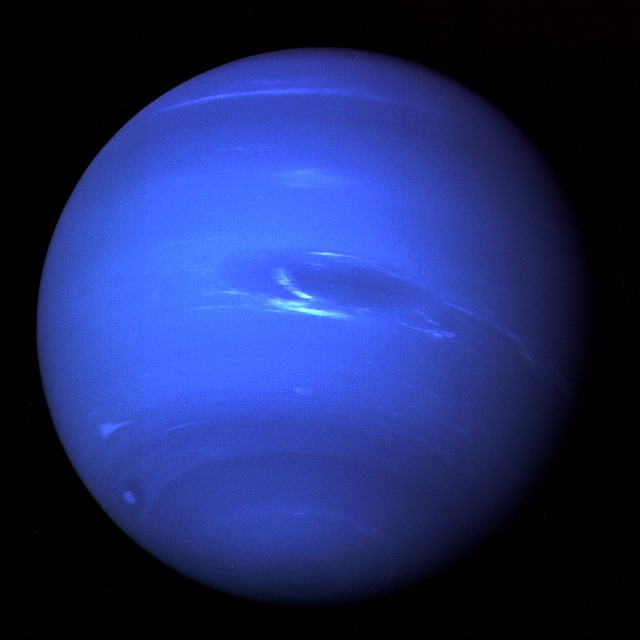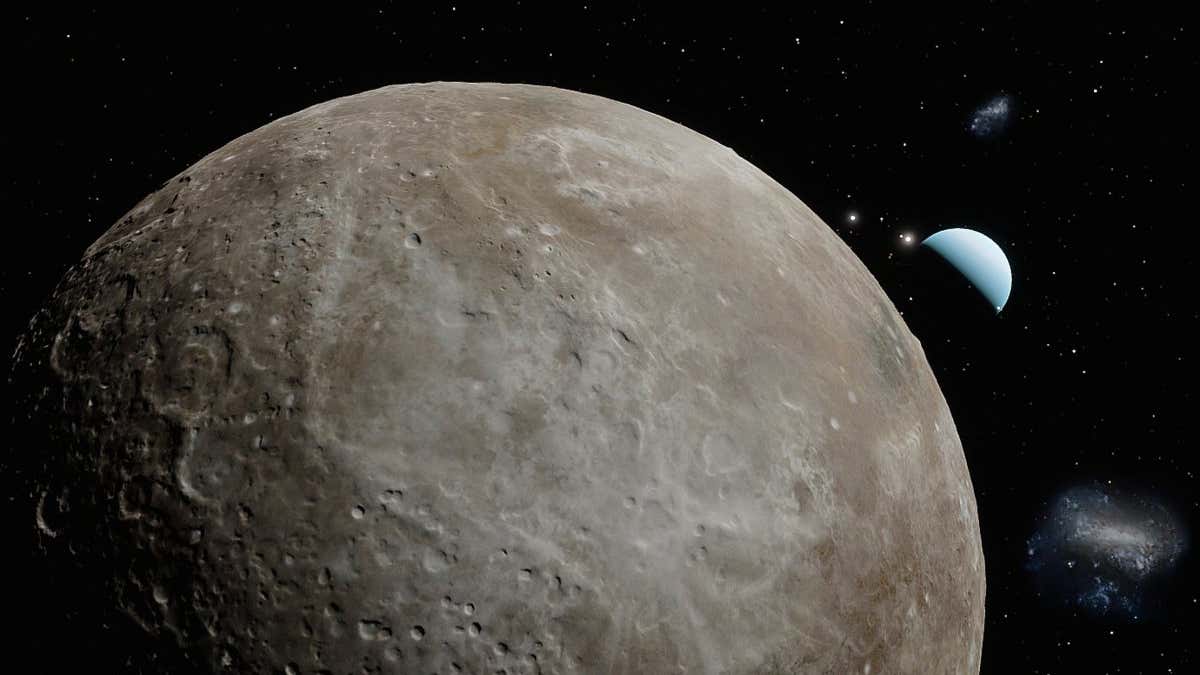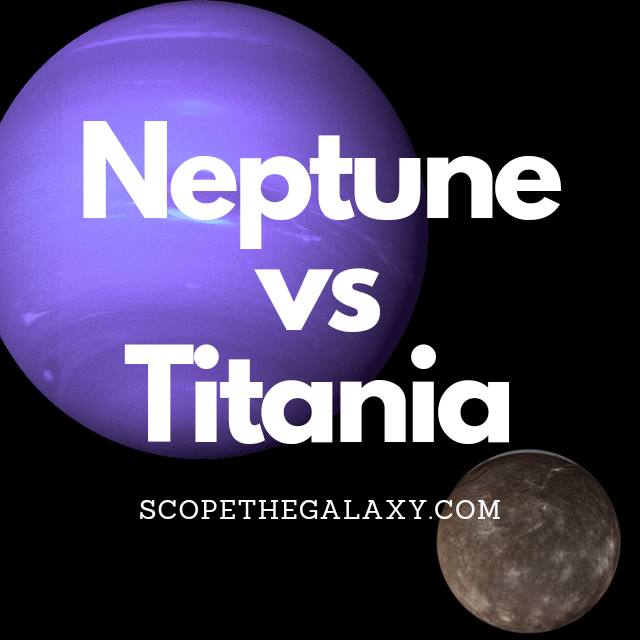*This post may contain affiliate links. This means we may make a commission if you purchase an item using one of our links*
The main differences between Neptune and Titania includes Neptune being a gas giant planet whereas Titania is simply Uranus’ largest moon, Neptune is much bigger with a diameter of 49,244km whilst Titania’s is 1576.8km and Neptune has 14 moons orbiting it whereas Titania has 0.
For a more detailed look at each celestial body continue reading for a more thorough breakdown of the similarities and differences between the two.
What Is The Planet Neptune?
Table of Contents

Neptune is the 8th farthest planet from the Sun and ranks among the bigger planets in our solar system. As the 8th farthest planet from the Sun, it does take Neptune a very long time to complete 1 orbital around the Sun.
This takes 165 years to complete which in comparison to the 16 hour 1 full spin around the axis is a massive difference.
In regards to its composition, Neptune is mostly made up of a thick swath of water closer to the center, methane, ammonia, hydrogen and helium molded around its Earth sized core.
As a result of the excess amount of methane and the inclusion of another undiscovered element within the atmosphere, Neptune’s color is a far deeper blue than the likes Uranus, which also has an abundantly methane based atmosphere.
The planet is 49,244km in diameter, making it roughly 4 times Earth’s diameter Earth, and would allow around 57 Earths to fit inside it. This also makes Neptune the 4th largest planet in our solar system.
Neptune is very cold mostly down to its distance from the Sun, where its atmospheric temperature sits between -220 to -230 degrees Celsius. Its core is far hotter coming in at 5,100 degrees Celsius and is the very likely cause for the liquid water present within the planet
Subsequently, the erratic temperature and gaseous composition of Neptune, is what constitute towards its turbulent behavior.
In fact Neptune has the fasted winds in our solar system, producing some that eclipse speeds of 2,000km per hour. The fastest winds on Earth would only be a fifth of these speeds at most.
At this moment in time we have discovered 14 moons orbiting Neptune and have also observed 5 thinner rings surrounding the ice giant.
What Is The Moon Titania?

Titania is the biggest of Uranus’s moons, with a circumference of 4,956km and a diameter of 1576.8km.
The high density of this moon suggests that it most likely formed from a collection of dust and debris leftover from the formation of Uranus or from the debris created in the collision that reportedly tilted Uranus onto its side. As a result Titania has a mass of 3.4 × 10^21 kg.
First discovered on 11th January 1787 (the same day as the discovery of Oberon, the second biggest moon of Uranus) by British astronomer William Herschel, the name “Titania” comes from the Shakespeare play, A Midsummer Night’s Dream. (Most of Uranus’ moons are named after Shakespeare’s characters.)
Having observed Titania for many years, scientists theorize that its composition is likely to be equal parts ice and rock, the latter of which may contain carbonaceous materials and organic compounds.
Research suggests that the moon most likely has a rocky core (accounting for 66% of the moon’s radius) and an icy mantle. If the mantle contains ammonia, it will act as antifreeze and make it possible for liquid water to exist. In this instance, the moon could possess a layer of liquid ocean around 50km thick.
Titania tilts slightly towards the equator of Uranus and is tidally locked to its planet. This means a Titania day is 8 days and 17 hours which would be the same for its orbital cycle. Titania has an average temperature of -203 degrees Celsius.
The planet Uranus is also tilted, with the moons orbiting on the equatorial plane, giving it extreme seasons. On Titania, the north and south poles experience 42 years of complete sunshine followed by 42 years of total darkness.
Scientists have observed the presence of large amounts of carbon dioxide, suggesting this may be the primary component of this moon’s atmosphere. Thanks to the tilted orbit, and a concentration of solar radiation from the poles, Titania probably maintains a carbon dioxide cycle, similar to the hydrogen cycle on Earth.
Similarities Between Neptune And Titania
There are a few similarities that Neptune and Titania share, which in this case includes the following:
- Both are a spherical shape.
- Both have a hotter core.
- Both are part of the same solar system.
- Neither have tectonic plates.
- Both orbit another object.
Differences Between Neptune And Titania
In regards the differences between Neptune and Titania, it includes the below.
- Titania orbits Uranus whilst Neptune only orbits the Sun.
- Neptune has 5 rings surrounding it whilst Titania has 0.
- Neptune is an ice based gas giant whilst Titania is a terrestrial based natural satellite.
- Neptune has 14 moons whilst Titania has 0.
- Neptune has a diameter of 49,244km whilst Titania’s diameter is 1,576.8km.
- Titania has a very thin exosphere composed mostly of carbon dioxide whilst Neptune is gas based, composed mostly of hydrogen, helium and methane.
- A day on Titania takes 8 days 17 hours whilst a Neptune takes 16 hours.
- It takes Titania 8 days 17 hours to orbit Uranus and around the Sun in 84 years whilst Neptune orbits the Sun in 165 years.
- Neptune has an axial tilt of 28 degrees whilst Titania axial tilt is closer to 0.
- Titania’s average temperature is around -203 degrees Celsius whilst Neptune has an average temperature of -220 to -230 degrees Celsius.
- Neptune is the most dense gas giant with a density of 1.64 g/cm³ whilst Titania’s density is 1.71 g/cm³.
- Neptune’s mass is 1.024 × 10^26 kg whilst Titania’s mass is 3.4 × 10^21 kg.
- Titania’s gravitational strength is 0.367 m/s² whilst Neptune is 11.15 m/s².
- Titania is tidally locked to Uranus whilst Neptune is not tidally locked to any entity.
- Neptune has a magnetosphere whilst Titania does not.
- Titania may have water within its surface whilst 80% of Neptune is made of icy materials.
Summary
Neptune and Titania do not have too much in common as Neptune is an ice based gas giant whereas Titania is a low density natural satellite.
As a result, despite being a part of the same solar system Neptune are completely different whether it be in regards to density, mass, the number of objects that orbit them and more as covered throughout this article.

